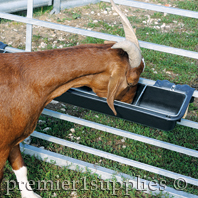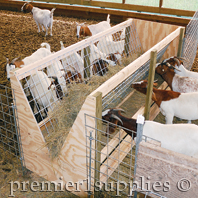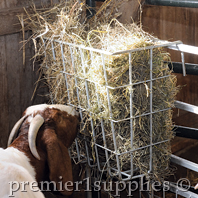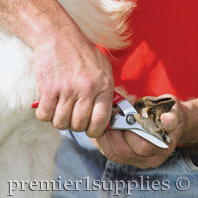GOAT FEEDERS THAT WORK!

GoatTuff Feeder
Designed specifically with goat behavior in mind. Galvanized steel grid:
| 1. |
Adds strength. |
| 2. |
Keeps young kids from lying in the feeder. |
| 3. |
Prevents boss goats from dominating while feeding. |
| 4. |
Stops goats from pushing feed out the end with their noses. |

Build Your Own Feeders
Why Premier's feeders please so many users…
| • |
Less waste—Wire panels prevent silage or hay from being pulled into the pen or onto the ground. Goats and sheep must work for each mouthful. |
| • |
Less risk of injury—Entering the pen is not required—so even children can safely feed hay and/or grain. |
| • |
Grain, silage and hay can all be fed in the same feeder—Saves space and reduces cost. |
| • |
Save $$—Make your own feeders and use local lumber to do so. |
| • |
Proven—They have been in use across the nation for years—and are now even copied by our competitors, which is the ultimate compliment. |
| • |
Of course, we’ve tweaked and improved the design along the way. (That’s who we are...) |
Order Premier's "Build Your Own Feeder" printed booklet or you can download 30" x 48" panel feeder or 24" x 48" panel feeder instructions for free.

X-Tuff Single Sided Feeder
Very strong. Everyone is impressed when they see these. Feeder stands up to abuse from big goats and sheep.
Grain/Hay Feeder
Eliminates need for separate grain and hay feeders. L-hooks handle the extra pressure of grain feeding.
PREMIER'S PICK
 ARS 140DXR Foot Trimmers
ARS 140DXR Foot Trimmers
Regarded as the gold standard tool for trimming goat and sheep hooves. Choice of smooth or serrated blades. Use our trimming stand to make this job easier.
Benefits:
| • |
Both ARS trimmers slice through hooves easily. |
| • |
Comfortable handles. |
| • |
Cutting stroke is ultra-smooth. |
| • |
Japanese steel blades famous for holding an edge.
|
| • |
Rounded blade tips allow cleaning manure from hooves with less risk of injury to you or an animal.
|

Watch our how-to video on "Trimming Hooves."
CUSTOMER REVIEWS
Average Rating:
     4.9 out of 5 4.9 out of 5
Would you recommend this product? Yes
These trimmers are the best we have ever used for trimming our goats' hooves! Highly recommend this product!
    
Hannah T from Oregon, 8/18/13
Would you recommend this product? Yes
Really great hoof trimmers for goats. Perfect size for my hand and easy to cut and trim their feet. Super sharp and sturdy as well.
    
Meg H from Maine, 8/25/12
|
 |
 |

Use the unique qualities of your herd to market goats directly to end consumers.
Direct Marketing Goat Meat
Want options for marketing your goats? We include articles from experts at Cornell University and the University of Alabama exploring marketing options with emphasis on farmgate marketing.
Direct marketing enables producers to communicate directly with the consumer re. preferred age, size, quality. And it usually means better prices for producers.
ON-FARM MARKETING TIPS
Direct On-Farm Marketing of Slaughter Lambs and Goats
By Tatiana Stanton, April 2013
Cornell Small Ruminant Extension Specialist
Originally written for The Goat Farmer in 2000, but substantially updated in 2013
There are many ways to market lambs and slaughter goats in the Northeast US. One method is to forgo middlemen and instead market your live animals directly from your farm to consumers. Direct on-farm marketing can be time consuming and stressful depending on how many of its inherent responsibilities you end up assuming. However, it's also a great chance to meet new folks and learn about a diverse range of cultures and ethnic groups. Before you attempt direct marketing, you need to determine what size and age lamb or goat kid makes the most sense for you to raise based on 1) what consumer demand is in your area and 2) what the costs of production and expected returns are to grow animals out for each category. You also need to understand what additional responsibilities and expenses you may incur when selling animals directly to consumers. This article outlines some of the duties involved in on-farm marketing.
By "direct on-farm marketing" I refer to two different scenarios, each operating under a different set of legal requirements. In the first scenario, the customers come to the farm and pick out an animal for their family's consumption, and either slaughter the animal at the farm or load it in their vehicle to slaughter elsewhere. The animal does not need to be slaughtered under USDA federal inspection because the activity falls under the "personal use exemption" 9 CFR 303.1(a)(1) which allows the owner of an animal to slaughter the animal themselves if it is for consumption only by them and their family and friends. The second scenario is the standard "freezer trade" where a customer orders an animal to be picked out for them and delivered to a slaughterhouse for slaughter and processing according to their cutting instructions for consumption by their family and friends. The customer does not necessarily have to see the animal in advance but should have communicated directly with you when placing the order for an animal. In this case the animal does not necessarily have to be slaughtered under USDA federal inspection but can instead be slaughtered at a custom exempt slaughterhouse under the "custom exemption" 9 CFR 303.1(a)(2). You can transport the animal to the slaughterhouse as a service for the new owner.
Depending on the clientele in your local area, you may not have much choice as to which of these scenarios you get involved with. Rather, your clientele may have a strong preference for only one method of direct marketing. Your ability to conform to their needs may determine whether on-farm direct marketing is going to work for you.
Prior to getting involved with either scenario, it's a good idea to form some plans for managing either situation on your particular farm. Here are some considerations: Initially a producer will need to advertise and actively seek clientele. It is a good idea to have the slaughter animals separated from the breeding stock or to have an easy way for customers to identify which is which. Posting prices and sticking with them will help cut down on the time spent bickering over prices. Farmers will need to decide if they are able and/or willing to be involved in the slaughter process by either providing a place for the customer to slaughter the animal or by providing transportation to a slaughter house. A farmer may instead want to work only with customers that pick out an animal and then transport it off farm for slaughter. Either of these channels may work well for farm families who enjoy dealing with numerous customers one-on-one and meeting new cultures.
Scenario 1—the consumer comes to your farm and may or may not slaughter there.
| 1. |
Clientele—Your clientele can range from recent immigrants (possibly refugees) to your country to well established citizens whose families pride themselves on keeping alive ethnic traditions of doing their own selection, slaughtering and preparation of lamb or goat for family celebrations. In either case you may find an extended family descending on your farm. Keep in mind that the visit to your farm may be considered a special outing. If you farm for the isolation, this family outing can be a little disconcerting though likely beneficial for your mental health! It can also be time consuming depending on how you organize the visit. |
Read More »
EXTENSION NEWS
Marketing of Meat Goats
By Steven M. Jones Associate Professor Animal Science
University of Arkansas
Mike McCarter County Extension Agent Staff Chair
Pike County, Arkansas
Steve Cheney Officer in Charge
Arkansas Livestock and Grain Market News Service
Introduction
Meat goat production is one of the oldest and the most widespread of animal enterprises in the world. At this point, it is the fastest-growing animal enterprise in the U.S. The economics of goat production is important to most people who raise goats, thus marketing is a major concern for most producers. The price of market animals dictates what can be spent on the practices associated with their production.
Most producers will not tolerate a nonpaying hobby operation. The enterprise must sooner or later become a paying operation, or it will cease to exist. A producer who cannot successfully market what he/she grows will not be in business for an extended period of time. A few people keep goats as pets and companion animals; however, the economics of goat production is such that most producers sell the animals, either for meat or for breeding purposes.
Some type of marketing plan is a necessity. It can be as simple as setting up a breeding plan to meet market demands, including places and types of customers. A good marketing plan is a complete description of how to get your product on the ground and off to market. Parts of the plan become templates and schedules for specific management activities and practices in the years to follow.
Most goats, regardless of the initial use, eventually end up in the meat market cycle. The meat market itself consists of all ages and types of animals. The amount a producer receives for a market animal depends on several factors including, but not limited to, the following: breed, size, age, sex, body condition and/or state of health.
Marketing
The first question most producers ask is “What do I charge for my animals or my product?” Getting the price structure correct for your business is the most effective marketing tool you have. The price you get for your goats will vary with the type of goats you sell and the methods used to market the goats.
Marketing initially is split into two phases: on-farm and off-farm. Both phases usually consist of selling by the head as is done with most other meat animals.Certain markets sell only graded animals. The meat markets for goats consist of different types and ages of animals. Some are listed below.
| • |
Easter Kids—This is a seasonal, usually ethnic, market. Goats should not be disbudded or castrated. Damraised animals are preferred, weighing from 16 to 40 pounds. Prices paid for these animals vary by year; however, traditionally, prices for Easter kids have averaged well above routine market prices, depending on size and condition of the animal. |
| • |
Cabrito—Cabrito is the meat of a milk-raised kid, usually 25 to 40 pounds in size, generally not castrated or disbudded. Presently, prices range from 70 cents to $1.40 per pound or more. As with other animals, price is usually determined by quality and demand. |
| • |
Chevon—Chevon is the meat from goats of any size and age, and the definition varies. |
Read More »
COMING SOON!
2014 Equipment Booklet
Look for Premier's new "Equipment Booklet" in your mailbox in October.
It includes, along with our standard products, the following new items:
| • |
Goat Bells: Wide choice of attractive designs that differ in tone, cost and size. |
| • |
Barn Bells: High-quality brass cast bells with ornamental black metal hardware. Make your house or barn distinctive. |
| • |
Qwik Tags and Applicator: Small, low-cost, temporary one-piece nylon tag for lambs and goat kids. |
| • |
EZ CatchNet: Nifty way to catch kids and lambs that are too small to be caught with a crook. Also works great for catching chickens and geese. |
| • |
Cradle: An easy-to-use-and-wash kid and lamb carrier. Plastic ridges securely grip slick newborns. |
| • |
Tooth File: Some nannies reject newborn kids that have sharp teeth. A quick touch with a file means fewer orphans. |
| • |
Large Braided Halters and Neck Ropes: For use on older animals. Same quality materials and construction as our other braided products. |
Note: New catalog items will be added to our website as they're available. When available, these will be added to our new products tab.
|
|